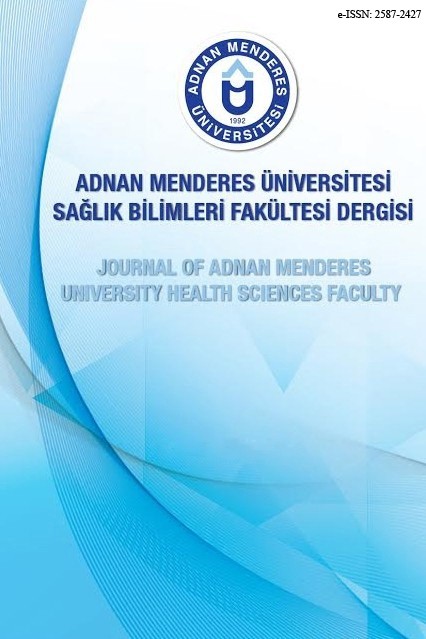13 VE 17 YAŞ ERKEK FUTBOL OYUNCULARININ FONKSİYONEL HAREKET TARAMASI SKORLARININ KARŞILAŞTIRILMASI
COMPARATİON OF FUNCTİONAL MOVEMENT SCREEN SCORES OF 13 AND 17 YEAR OLD SOCCER PLAYER
___
- 1. Gabbe, B. J., Finch, C. F., Cameron, P. A., & Williamson, O. D. Incidence of serious injury and death during sport and recreation activities in Victoria, Australia. British Journal of Sports Medicine, 2005,39(8): 573-577.
- 2. Herbert, RD and Gabriel, M. Effects of stretching before and after exercise on muscle soreness and risk of injury: Systematic review. BMJ, 2002, 325(7362): 468, 2002.
- 3. Pope, RP, Herbert, RD, Kirwan, JD, and Graham, BJ. A randomized trial of preexercise stretching for prevention of lower-limb injury. Med Sci Sports Exerc 2000,32(2): 271–277.
- 4. Nadler, SF, Malanga, GA, Feinberg, JH, Ruanni, M, Moley, P, and Foye, P. Functional performance deficits in athletes with previous lower extremity injury. Clin J Sport Med 2002,12(2): 73–78.
- 5. Plisky, PJ, Rauh, MJ, Kaminski, TW, and Underwood, FB. Star Excursion Balance Test as a predictor of lower extremity injury in high school basketball players. J Orthop Sports Phys Ther 2006, 36(12): 911–919.
- 6. Carling, C., Bloomfield, J., Nelsen, L., & Reilly, T. The role of motion analysis in elite soccer. Sports medicine, 2008,38(10): 839-862.
- 7. Cook G; Burton L; Hoogenboom B. Pre-participation screening: the use of fundamental movements as an assessment of function–part 1. North American journal of sports physical therapy: NAJSPT, 2006, 1(2): 62.
- 8. Cook G; Burton L; Hoogenboom B. Pre-participation screening: The use of fundamental movements as an assessment of function–Part 2. North American journal of sports physical therapy: NAJSPT, 2006, 1(3): 132.
- 9. Minick, K. I., Kiesel, K. B., Burton, L., Taylor, A., Plisky, P., & Butler, R. J. Interrater reliability of the functional movement screen. The Journal of Strength & Conditioning Research, 2010,24(2): 479-486.
- 10. Onate, J. A., Dewey, T., Kollock, R. O., Thomas, K. S., Van Lunen, B. L., DeMaio, M., & Ringleb, S. I. Real-time intersession and interrater reliability of the functional movement screen. The Journal of Strength & Conditioning Research, 2012,26(2): 408-415.
- 11. Mokha, M., Sprague, P. A., & Gatens, D. R. Predicting musculoskeletal injury in National Collegiate Athletic Association Division II athletes from asymmetries and individual-test versus composite functional movement screen scores. Journal of athletic training, 2016,51(4): 276-282.
- 12. Yeung, J., Cleves, A., Griffiths, H., & Nokes, L. Mobility, proprioception, strength and FMS as predictors of injury in professional footballers. BMJ open sport & exercise medicine, 2016,2(1): e000134.
- 13. Warren, M., Smith, C. A., & Chimera, N. J. Association of the functional movement screen with injuries in division I athletes. Journal of sport rehabilitation, 2015,24(2): 163-170.
- 14. Kraus, K., Schütz, E., Taylor, W. R., & Doyscher, R. Efficacy of the functional movement screen: a review. The Journal of Strength & Conditioning Research, 2014,28(12): 3571-3584.
- 15. Portas, M. D., Parkin, G., Roberts, J., & Batterham, A. M. Maturational effect on Functional Movement Screen™ score in adolescent soccer players. Journal of Science and Medicine in Sport, 2016,19(10): 854-858.
- 16. Lloyd, R. S., Oliver, J. L., Radnor, J. M., Rhodes, B. C., Faigenbaum, A. D., & Myer, G. D. Relationships between functional movement screen scores, maturation and physical performance in young soccer players. Journal of sports sciences, 2015,33(1): 11-19.
- Yayın Aralığı: Yılda 3 Sayı
- Başlangıç: 2017
- Yayıncı: Aydın Adnan Menderes Üniversitesi
Ayşe Merve TAT, Necati Muhammed TAT, Serdar ARSLAN, Neslihan Altuntaş YILMAZ
13 VE 17 YAŞ ERKEK FUTBOL OYUNCULARININ FONKSİYONEL HAREKET TARAMASI SKORLARININ KARŞILAŞTIRILMASI
Serdar Arslan, Engin DİNÇ, Gökmen Yapalı
İNTRAKRANİYAL APSE SAPTANAN KONJENİTAL KALP HASTALIKLI OLGU
Hatice Feray ARI, Timur MEŞE, Murat Muhtar YILMAZER, Murat ARI, Hasan AĞIN, Emre ÇAVUŞOĞLU, Tuncer TURHAN, İlker DEVRİM
